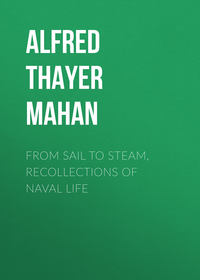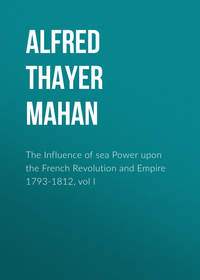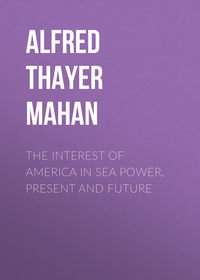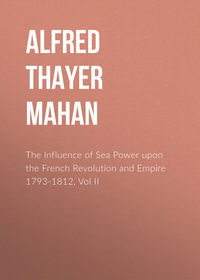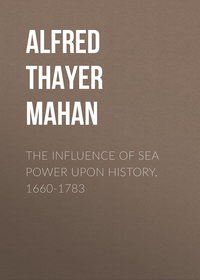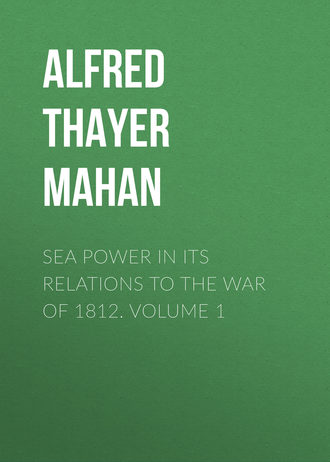 полная версия
полная версияSea Power in its Relations to the War of 1812. Volume 1
Considered apart from the question of military readiness, in which the United States was so lamentably deficient, the natural advantages in her possession for the invasion of Canada were very great. The Hudson River, Lake George, and Lake Champlain furnished a line of water communication, for men and supplies, from the very heart of the resources of the country, centring about New York. This was not indeed continuous; but it was consecutive, and well developed. Almost the whole of it lay within United States territory; and when the boundary line on Champlain was reached, Montreal was but forty miles distant. Towards Kingston, also, there was a similar line, by way of the Mohawk River and Lake Oneida to Oswego, whence a short voyage on Ontario reached the American naval station at Sackett's Harbor, thirty miles from Kingston. As had been pointed out six months before the war began, by General Armstrong, who became the United States Secretary of War in January, 1813, when the most favorable conditions for initiative had already been lost, these two lines were identical as far as Albany. "This should be the place of rendezvous; because, besides other recommendations, it is here that all the roads leading from the central portion of the United States to the Canadas diverge—a circumstance which, while it keeps up your enemy's doubts as to your real point of attack, cannot fail to keep his means of defence in a state of division."417 The perplexity of an army, thus uncertain upon which extreme of a line one hundred and fifty miles long a blow will fall, is most distressing; and trebly so when, as in this case, the means of communication from end to end are both scanty and slow. "The conquest of Lower Canada," Sir James Craig had written, "must still be effected by way of Lake Champlain;" but while this was true, and dictated to the officer charged with the defence the necessity of keeping the greater part of his force in that quarter, it would be impossible wholly to neglect the exposure of the upper section. This requirement was reflected in the disposition of the British forces when war began; two thirds being below Montreal, chiefly at Quebec, the remainder dispersed through Upper Canada. To add to these advantages of the United States, trivial as was the naval force of either party on Champlain, the preponderance at this moment, and throughout the first year, was in her hands. She was also better situated to enlarge her squadrons on all the lakes, because nearer the heart of her power.
Circumstances thus had determined that, in general plan, the seaboard represented the defensive scene of campaign for the United States, while the land frontier should be that of offensive action. It will be seen, with particular reference to the latter, that the character of the front of operations prescribed the offensive in great and concentrated force toward the St. Lawrence, with preparations and demonstrations framed to keep the enemy doubtful to the last possible moment as to where the blow should fall; while on the western frontier, from Michilimackinac to Niagara, the defensive should have been maintained, qualifying this term, however, by the already quoted maxim of Napoleon, that no offensive disposition is complete which does not keep in view, and provide for, offensive action, if opportunity offer. Such readiness, if it leads to no more, at least compels the opponent to retain near by a degree of force that weakens by so much his resistance in the other quarter, against which the real offensive campaign is directed.
Similarly, the seaboard, defensive in general relation to the national plan as a whole, must have its own particular sphere of offensive action, without which its defensive function is enfeebled, if not paralyzed. Having failed to create before the war a competent navy, capable of seizing opportunity, when offered, to act against hostile divisions throughout the world, it was not possible afterwards to retrieve this mistake. Under the circumstances existing in 1812, the previous decade having been allowed by the country to pass in absolute naval indifference, offensive measures were necessarily confined to the injury of the enemy's commerce. Had a proper force existed, abundant opportunity for more military action was sure to occur. The characteristics of parts of the American coast prevented close blockade, especially in winter; and the same violent winds which forced an enemy's ships off, facilitated egress under circumstances favoring evasion. Escape to the illimitable ocean then depended at worst upon speed. This was the case at Boston, which Commodore Bainbridge before the war predicted could not be effectually blockaded; also at Narragansett, recommended for the same reason by Commodore John Rodgers; and in measure at New York, though there the more difficult and shoaler bar involved danger and delay to the passage of heavy frigates. In this respect the British encountered conditions contrary to those they had know before the French Atlantic ports, where the wind which drove the blockaders off prevented the blockaded from leaving. Once out and away, a squadron of respectable force would be at liberty to seek and strike one of the minor divisions of the enemy, imposing caution as to how he dispersed his ships in face of such a chance. To the south, both the Delaware and Chesapeake could be sealed almost hermetically by a navy so superior as was that of Great Britain; for the sheltered anchorage within enabled a fleet to lie with perfect safety across the path of all vessels attempting to go out or in. South of this again, Wilmington, Charleston, and Savannah, though useful commercial harbors, had not the facilities, natural or acquired, for sustaining a military navy. They were not maritime centres; the commerce of the South, even of Baltimore with its famous schooners, being in peace carried on chiefly by shipping which belonged elsewhere—New England or foreign. The necessities of a number of armed ships could not there be supplied; and furthermore, the comparatively moderate weather made the coast at once more easy and less dangerous for an enemy to approach. These ports, therefore, were entered only occasionally, and then by the smaller American cruisers.
For these reasons the northern portion of the coast, with its rugged shores and tempestuous weather, was the base of such offensive operations as the diminutive numbers of the United States Navy permitted. To it the national ships sought to return, for they could enter with greater security, and had better prospects of getting out again when they wished. In the Delaware, the Chesapeake, and on the Southern coast, the efforts of the United States were limited to action strictly, and even narrowly, defensive in scope. Occasionally, a very small enemy's cruiser might be attacked; but for the most part people were content merely to resist aggression, if attempted. The harrying of the Chesapeake, and to a less extent of the Delaware, are familiar stories; the total destruction of the coasting trade and the consequent widespread distress are less known, or less remembered. What is not at all appreciated is the deterrent effect upon the perfect liberty enjoyed by the enemy to do as they pleased, which would have been exercised by a respectable fighting navy; by a force in the Northern ports, equal to the offensive, and ready for it, at the time that Great Britain was so grievously preoccupied by the numerous fleet which Napoleon had succeeded in equipping, from Antwerp round to Venice. Of course, after his abdication in 1814, and the release of the British navy and army, there was nothing for the country to do, in the then military strength of the two nations, save to make peace on the best terms attainable. Having allowed to pass away, unresented and unimproved, years of insult, injury, and opportunity, during which the gigantic power of Napoleon would have been a substantial, if inert, support to its own efforts at redress, it was the mishap of the United States Government to take up arms at the very moment when the great burden which her enemy had been bearing for years was about to fall from his shoulders forever.
CHAPTER VI
EARLY CRUISES AND ENGAGEMENTS: THE "CONSTITUTION" AND "GUERRIÈRE." HULL'S OPERATIONS AND SURRENDER
War was declared on June 18. On the 21st there was lying in the lower harbor of New York a division of five United States vessels under the command of Commodore John Rodgers. It consisted of three frigates, the "President" and "United States," rated of 44 guns, the "Congress" of 38, the ship-rigged sloop of war "Hornet" of 18, and the brig "Argus" of 16. This division, as it stood, was composed of two squadrons; that of Rodgers himself, and that of Commodore Stephen Decatur, the latter having assigned to him immediately the "United States," the "Congress," and the "Argus." There belonged also to Rodgers' particular squadron the "Essex," a frigate rated at 32 guns. Captain David Porter, one of the most distinguished names in American naval annals, commanded her then, and until her capture by a much superior force, nearly two years later; but at this moment she was undergoing repairs, a circumstance which prevented her from accompanying the other vessels, and materially affected her subsequent history.
It may be mentioned, as an indication of naval policy, that although Rodgers and Decatur each had more than one vessel under his control, neither was given the further privilege and distinction, frequent in such cases, of having a captain to command the particular ship on which he himself sailed. This, when done, introduces a very substantial change in the position of the officer affected. He is removed from being only first among several equals, and is advanced to a superiority of grade, in which he stands alone, with consequent enhancement of authority. Rodgers was captain of the "President" as well as commodore of the small body of vessels assigned to him; Decatur held the same relation to the frigate "United States," and to her consorts. Though apparently trivial, the circumstance is not insignificant; for it indicates clearly that, so far as the Navy Department then had any mind, it had not yet made it up as to whether it would send out its vessels as single cruisers, or combine them into divisions, for the one operation open to the United States Navy, namely, the destruction of the enemy's commerce. With divisions permanently constituted as such, propriety and effective action would have required the additional dignity for the officer in general charge, and they themselves doubtless would have asked for it; but for ships temporarily associated, and liable at any moment to be scattered, not only was the simple seniority of naval rank sufficient, but more would have been inexpedient. The commodores, now such only by courtesy and temporary circumstance, would suffer no derogation if deprived of ships other than their own; whereas the more extensive function, similarly curtailed, would become a mere empty show, a humiliation which no office, civil or military, can undergo without harm.
This indecision of the Department reflected the varying opinions of the higher officers of the service, which in turn but reproduced different schools of thought throughout all navies. Historically, as a military operation, for the injury of an enemy's commerce and the protection of one's own, it may be considered fairly demonstrated that vessels grouped do more effective work than the same number scattered. This is, of course, but to repeat the general military teaching of operations of all kinds. It is not the keeping of the several vessels side by side that constitutes the virtue of this disposition; it is the placing them under a single head, thereby insuring co-operation, however widely dispersed by their common chief under the emergency of successive moments. Like a fan that opens and shuts, vessels thus organically bound together possess the power of wide sweep, which insures exertion over a great field of ocean, and at the same time that of mutual support, because dependent upon and controlled from a common centre. Such is concentration, reasonably understood; not huddled together like a drove of cattle, but distributed with a regard to a common purpose, and linked together by the effectual energy of a single will.
There is, however, in the human mind an inveterate tendency to dispersion of effort, due apparently to the wish to do at once as many things as may be; a disposition also to take as many chances as possible in an apparent lottery, with the more hope that some one of them will come up successful. Not an aggregate big result, and one only, whether hit or miss, but a division of resources and powers which shall insure possible compensation in one direction for what is not gained, or may even be lost, in another. The Navy Department, when hostilities were imminent, addressed inquiries to several prominent officers as to the best means of employing the very small total force available. The question involved the direction of effort, as well as the method; but as regards the former of these, the general routes followed by British commerce, and the modes of protecting it, were so far understood as to leave not much room for differences of opinion.
Rodgers may have been unconsciously swayed by the natural bias of an officer whose seniority would insure him a division, if the single-cruiser policy did not prevail. Of the replies given, however, his certainly was the one most consonant with sound military views.418 Send a small squadron, of two or three frigates and a sloop, to cruise on the coast of the British Islands, and send the light cruisers to the West Indies; for, though he did not express it, in the gentle breezes and smooth seas of the tropics small cruisers have a much better chance to avoid capture by big ships than in the heavy gales of the North Atlantic. This much may be termed the distinctly offensive part of Rodgers' project. For the defensive, employ the remainder of the frigates, singly or in squadron, to guard our own seaboard; either directly, by remaining off the coast, or by taking position in the track of the trade between Great Britain and the St. Lawrence. Irrespective of direct captures there made, this course would contribute to protect the access to home ports, by drawing away the enemy's ships of war to cover their own threatened commerce. Alike in the size of his foreign squadron, and in the touch of uncertainty as to our own coasts, "singly or in squadron," Rodgers reflected the embarrassment of a man whose means are utterly inadequate to the work he wishes to do. One does not need to be a soldier or a seaman to comprehend the difficulty of making ends meet when there is not enough to go round.
Decatur and Bainbridge, whose written opinions are preserved, held views greatly modified from those of Rodgers, or even distinctly opposed to them. "The plan which appears to me best calculated for our little navy to annoy the trade of Great Britain," wrote Decatur,419 "would be to send them out distant from our own coast, singly, or not more than two frigates in company, without specific instructions; relying upon the enterprise of their officers. Two frigates cruising together would not be so easily traced by an enemy as a greater number; their movements would be infinitely more rapid; they would be sufficiently strong in most instances to attack a convoy, and the probability is they would not meet with a superior cruising force. If, however, they should meet a superior, and cannot avoid it, we would not have to regret the whole of our marine crushed at one blow." Bainbridge is yet more absolute. "I am anxious to see us all dispersed about various seas. If we are kept together in squadron, or lying in port, the whole are scarcely of more advantage than one ship. I wish all our public vessels here [Boston] were dispersed in various ports, for I apprehend it will draw speedily a numerous force of the enemy to blockade or attack."420 At the moment of writing this, Rodgers' squadron was in Boston, having returned from a cruise, and the "Constitution" also, immediately after her engagement with the "Guerrière."
It will be observed that, in spirit even more than in letter, Rodgers' leading conception is that of co-operation, combined action. First, he would have a Department general plan, embracing in a comprehensive scheme the entire navy and the ocean at large, in the British seas, West Indies, and North Atlantic; each contributing, by its particular action and impression, to forward the work of the others, and so of the whole. Secondly, he intimates, not obscurely, though cautiously, in each separate field the concerted action of several ships is better than their disconnected efforts. Decatur and Bainbridge, on the contrary, implicitly, and indeed explicitly, favor individual movement. They would reject even combination by the Department—"no specific instructions, rely upon the enterprise of the officers." Nor will they have a local supervision or control in any particular; two frigates at the most are to act together, singly even is preferable, and they shall roam the seas at will.
There can be little doubt as to which scheme is sounder in general principle. All military experience concurs in the general rule of co-operative action; and this means concentration, under the liberal definition before given—unity of purpose and subordination to a central control. General rules, however, must be intelligently applied to particular circumstances; and it will be found by considering the special circumstances of British commerce, under the war conditions of 1812, that Rodgers' plan was particularly suited to injure it. It is doubtless true that if merchant vessels were so dispersed over the globe, that rarely more than one would be visible at a time, one ship of war could take that one as well as a half-dozen could. But this was not the condition. British merchant ships were not permitted so to act. They were compelled to gather at certain centres, and thence, when enough had assembled, were despatched in large convoys, guarded by ships of war, in force proportioned to that disposable at the moment by the local admiral, and to the anticipated danger. Consequently, while isolated merchant ships were to be met, they were but the crumbs that fell from the table, except in the near vicinity of the British Islands themselves.
Such were the conditions while Great Britain had been at war with France alone; but the declaration of the United States led at once to increased stringency. All licenses to cross the Atlantic without convoy were at once revoked, and every colonial and naval commander lay under heavy responsibility to enforce the law of convoy. Insurance was forfeited by breach of its requirements; and in case of parting convoy, capture would at least hazard, if not invalidate, the policy. Under all this compulsion, concentrated merchant fleets and heavy guards became as far as possible the rule of action. With such conditions it was at once more difficult for a single ship of war to find, and when found to deal effectually with, a body of vessels which on the one hand was large, and yet occupied but a small space relatively to the great expanse of ocean over which the pursuer might roam fruitlessly, missing continually the one moving spot he sought. For such a purpose a well-handled squadron, scattering within signal-distance from each other, or to meet at a rendezvous, was more likely to find, and, having found, could by concerted action best overcome the guard and destroy the fleet.
On June 22, 1812, the Navy Department issued orders for Rodgers,421 which are interesting as showing its ideas of operations. The two squadrons then assembled under him were to go to sea, and there separate. He himself, with the frigates "President," "Essex," and "John Adams," sloop "Hornet," and the small brig "Nautilus," was to go to the Capes of the Chesapeake, and thence cruise eastwardly, off and on. Decatur's two frigates, with the "Argus," would cruise southwardly from New York. It was expected that the two would meet from time to time; and, should combined action be advisable, Rodgers had authority to unite them under his broad pendant for that purpose. The object of this movement was to protect the commerce of the country, which at this time was expected to be returning in great numbers from the Spanish peninsula; whither had been hurried every available ship, and every barrel of flour in store, as soon as the news of the approaching embargo of April 4 became public. "The great bulk of our returning commerce," wrote the secretary, "will make for the ports between the Chesapeake and our eastern extremities; and, in the protection to be afforded, such ports claim particular attention."
The obvious comment on this disposition is that protection to the incoming ships would be most completely afforded, not by the local presence of either of these squadrons, but by the absence of the enemy. This absence was best insured by beating him, if met; and in the then size of the British Halifax fleet it was possible that a detachment sent from it might be successfully engaged by the joint division, though not by either squadron singly. The other adequate alternative was to force the enemy to keep concentrated, and so to cover as small a part as might be of the homeward path of the scattered American trade. This also was best effected by uniting our own ships. Without exaggerating the danger to the American squadrons, needlessly exposed in detail by the Department's plan, the object in view would have been attained as surely, and at less risk, by keeping all the vessels together, even though they were retained between Boston Bay and the Capes of the Chesapeake for the local defence of commerce. In short, as was to be expected from the antecedents of the Government, the scheme was purely and narrowly defensive; there was not in it a trace of any comprehension of the principle that offence is the surest defence. The opening words of its letter defined the full measure of its understanding. "It has been judged expedient so to employ our public armed vessels, as to afford to our returning commerce all possible protection." It may be added, that to station on the very spot where the merchant vessels were flocking in return, divisions inferior to that which could be concentrated against them, was very bad strategy; drawing the enemy by a double motive to the place whence his absence was particularly desirable.
The better way was to influence British naval action by a distinct offensive step; by a movement of the combined divisions sufficiently obvious to inspire caution, but yet too vague to admit of precision of direction or definite pursuit. In accordance with the general ideas formulated in his letter, before quoted, Rodgers had already fixed upon a plan, which, if successful, would inflict a startling blow to British commerce and prestige, and at the same time would compel the enemy to concentrate, thus diminishing his menace to American shipping. It was known to him that a large convoy had sailed from Jamaica for England about May 20. The invariable course of such bodies was first to the north-northeast, parallel in a general sense to the Gulf Stream and American coast, until they had cleared the northeast trades and the belt of light and variable winds above them. Upon approaching forty degrees north latitude, they met in full force the rude west winds, as the Spanish navigators styled them, and before them bore away to the English Channel. That a month after their starting Rodgers should still have hoped to overtake them, gives a lively impression of the lumbering slowness of trade movement under convoy; but he counted also upon the far swifter joint speed of his few and well-found ships. To the effective fulfilment of his double object, defensive and offensive, however, he required more ships than his own squadron, and he held his course dependent upon Decatur joining him.422
On June 21 Decatur did join, and later in the same day arrived a Department order of June 18 with the Declaration of War. Within an hour the division of five ships was under way for sea. In consequence of this instant movement Rodgers did not receive the subsequent order of the Department, June 22, the purport of which has been explained and discussed. Standing off southeasterly from Sandy Hook, at 3 A.M. of June 23 was spoken an American brig, which four days before had seen the convoy steering east in latitude 36°, longitude 67°, or about three hundred miles from where the squadron then was. Canvas was crowded in pursuit, but three hours later was sighted in the northeast a large sail heading toward the squadron. The course of all the vessels was changed for her; but she, proving to be British,—the "Belvidera," rated 32, and smaller than any one of the American frigates,—speedily turned and took flight. Pursuit was continued all that day and until half an hour before midnight, the "President" leading as the fastest ship; but the British vessel, fighting for her life, and with the friendly port of Halifax under her lee, could resort to measures impossible to one whose plan of distant cruising required complete equipment, and full stores of provisions and water. Boats and spare spars and anchors were thrown overboard, and fourteen tons of drinking water pumped out. Thus lightened, after being within range of the "President's" guns for a couple of hours, the "Belvidera" drew gradually away, and succeeded in escaping, having received and inflicted considerable damage. In explanation of such a result between two antagonists of very unequal size, it must be remembered that a chasing ship of those days could not fire straight ahead; while in turning her side to bring the guns to bear, as the "President" several times did, she lost ground. The chased ship, on the other hand, from the form of the stern, could use four guns without deviating from her course.


